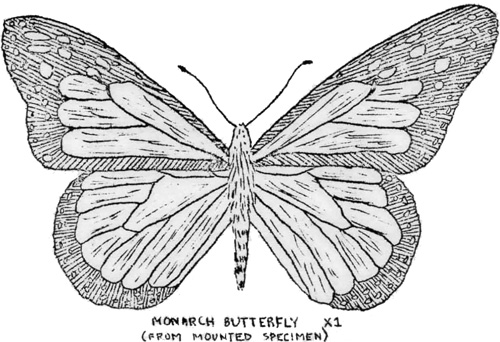|
NATURE NOTES FROM ACADIA
| Volume 3 |
September-October, 1934 |
Number 5 |
THE MONARCH BUTTERFLY IN ACADIA
A monarch among its kind, the Monarch Butterfly has quickened the
hearts of innumerable nature lovers. Perhaps its majestic flight and
bearing gave rise to its name; but the possession of scent pouches or
scent glands, which are supposed to protect it from its enemies, and its
migratory habit are responsible for most of the interest in it. For both
are unusual characteristics among our butterflies. Its extraordinary
migrations have been the subject of many printed pages.
None were seen in 1931 when the writer came to Acadia National Park.
Local observers stated that the Monarch had been very rarely found here
due to the absence of its food plant. In 1932 one or two individuals
were seen. In 1933 a number of specimens were seen or captured. Now in
1934 it has increased until six to eight may be seen at a time feeding
in a patch of thistles or goldenrods.
The life history of the Monarch Butterfly is most interesting. It
feeds on milkweeds in the larval state. The butterflies which migrate
northward in the spring of the year place their ovate tapering eggs on
the milkweed leaves. The caterpillars are yellow and green with narrow
transverse bands of black. They have long fleshy black processes arising
from near each end. To many people they are unusually interesting and
attractive, but some people who have not watched their interesting
transformations think they are repulsive worms. When fully grown the
caterpillar spins a pad of silk from which the chrysalid will hang. The
caterpillar skin splits open and is pushed off. A lovely pea-green
chrysalid with golden spots remains. In this vault-like structure great
changes take place; soon the shroud splits open and a monarch comes
forth to spread pinions which will bear it for hundreds or even
thousands of miles. Lack of milkweed plants prevents its breeding in
this locality. We see it slowly drifting from flower to flower sucking
the nectar in preparation for its long journey.

The Monarch feeds on the nectar of thistles, goldenrods, and many
other flowers. As fall approaches it begins drifting southward. From the
many patches of milkweed in Canada and the Northern States little groups
are formed, and later as the migration becomes more marked large flocks
collect. These roost in a body on one or more trees, and they have been
known to cover the leafless trees as thickly as the recently fallen
leaves did. The individuals seen in Acadia have drifted here from the
mainland to the northward. After feeding for a time they will move on to
join the swelling flock which are moving southward. Due to the
conformation of land and water, lines of migration converge in places
and great numbers of individuals pass through some sections such as the
north shore of Long Island and the coast of New Jersey. The acrid or
nauseating qualities of their scent pouches are believed to protect them
from birds and other predators. In the spring battered Monarchs move
northward out of the Gulf States. They may be the ones which went south
in the fall or they may be their offspring - no one knows. Searching for
milkweed plants on which to lay their eggs they fly northward. At this
season the direction of their movement carries them inland and they are
rarely seen in Acadia; however a few were seen last spring. The reason
for the great increase in the number of Monarchs coming to this region
is probably that the species has greatly increased of recent years. Its
kind is at flood tide. May its numbers long swell like the breakers
which roll up on Acadia's granite shores.
- Dr. A. E. Brower
Asst. State Entomologist
Maine Forest Service
A Word Further Concerning the Monarch. - In an article
entitled, "Our Butterflies Invade England," which appeared in The New
York Times for September 30, 1934, mention was made of the Monarch and a
few other American butterflies which had been observed in England. In
this article the entomological expert of The Times of London, writing of
the Monarch, remarks as follows:
"'It is a commonplace of American natural history that this insect,
habitually and in great numbers, makes migrations of hundreds of miles
over the land. The ocean is another matter, and it was at one time
supposed that the very occasional specimens noticed here must have been
carried most of the way by ships.
"'Now, however, it is no longer doubted that his own motive power
conveys the Monarch to our shores - across 1,500 miles of watery waste!
The question may be held to have been settled by the experiences of
1933.'"
- A. S.
| 
